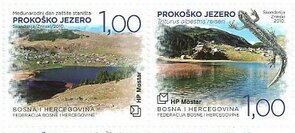Se-tenant: Prokoško Jezero and Eastern Alpine Newt (Bosnia and Herzegovina, Croatian Admin 2010)
Prokoško Jezero and Eastern Alpine Newt (Bosnia and Herzegovina, Croatian Admin 2010)
06 October (Bosnia and Herzegovina, Croatian Admin ) within release International Protection Of Habitats goes into circulation Se-tenant Prokoško Jezero and Eastern Alpine Newt face value 2*1 Bosnia and Herzegovina convertible mark
| Se-tenant Prokoško Jezero and Eastern Alpine Newt in catalogues | |
|---|---|
| Michel: | Mi: BA-HB 296-297 |
| Stanley Gibbons: | Sg: BA-HB C297a |
Se-tenant is square format.
Also in the issue International Protection Of Habitats:
- Mini Sheet - Prokoško Jezero and Eastern Alpine Newt face value 8*1;
- Se-tenant - Prokoško Jezero and Eastern Alpine Newt face value 2*1;
Se-tenant Prokoško Jezero and Eastern Alpine Newt it reflects the thematic directions:
Amphibians are ectothermic, anamniotic, four-limbed vertebrate animals that constitute the class Amphibia. In its broadest sense, it is a paraphyletic group encompassing all tetrapods, excluding the amniotes (tetrapods with an amniotic membrane, such as modern reptiles, birds, and mammals). All extant (living) amphibians belong to the monophyletic subclass Lissamphibia, with three living orders: Anura (frogs), Urodela (salamanders), and Gymnophiona (caecilians). Evolved to be mostly semiaquatic, amphibians have adapted to inhabit a wide variety of habitats, with most species living in freshwater, wetland or terrestrial ecosystems (such as riparian woodland, fossorial and even arboreal habitats). Their life cycle typically starts out as aquatic larvae with gills known as tadpoles, but some species have developed behavioural adaptations to bypass this.
Animals are multicellular, eukaryotic organisms of the kingdom Animalia (also called Metazoa). All animals are motile, meaning they can move spontaneously and independently, at some point in their lives. Their body plan eventually becomes fixed as they develop, although some undergo a process of metamorphosis later on in their lives. All animals are heterotrophs: they must ingest other organisms or their products for sustenance.
Environmental protection is the practice of protecting the natural environment by individuals, groups and governments.Its objectives are to conserve natural resources and the existing natural environment and, where it is possible, to repair damage and reverse trends.
A lake is a naturally occurring, relatively large and fixed body of water on the Earth's surface. It is localized in a basin or interconnected basins surrounded by dry land. Lakes lie completely on land and are separate from the ocean, although they may be connected with the ocean by rivers, such as Lake Ontario. Most lakes are freshwater and account for almost all the world's surface freshwater, but some are salt lakes with salinities even higher than that of seawater. Lakes vary significantly in surface area and volume.




